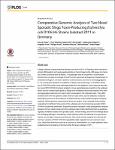Comparative Genomic Analysis of Two Novel Sporadic Shiga Toxin-Producing Escherichia coli O104:H4 Strains Isolated 2011 in Germany
Tietze, Erhard
Dabrowski, Piotr Wojtek
Prager, Rita
Radonić, Aleksandar
Fruth, Angelika
Aurass, Philipp
Nitsche, Andreas
Mielke, Martin
Flieger, Antje
A large outbreak of gastrointestinal disease occurred in 2011 in Germany which resulted in almost 4000 patients with acute gastroenteritis or hemorrhagic colitis, 855 cases of a hemolytic uremic syndrome and 53 deaths. The pathogen was an uncommon, multiresistant Escherichia coli strain of serotype O104:H4 which expressed a Shiga toxin characteristic of enterohemorrhagic E. coli and in addition virulence factors common to enteroaggregative E. coli. During post-epidemic surveillance of Shiga toxin-producing E. coli (STEC) all but two of O104:H4 isolates were indistinguishable from the epidemic strain. Here we describe two novel STEC O104:H4 strains isolated in close spatiotemporal proximity to the outbreak which show a virulence gene panel, a Shiga toxin-mediated cytotoxicity towards Vero cells and aggregative adherence to Hep-2 cells comparable to the outbreak strain. They differ however both from the epidemic strain and from each other, by their antibiotic resistance phenotypes and some other features as determined by routine epidemiological subtyping methods. Whole genome sequencing of these two strains, of ten outbreak strain isolates originating from different time points of the outbreak and of one historical sporadic EHEC O104:H4 isolate was performed. Sequence analysis revealed a clear phylogenetic distance between the two variant strains and the outbreak strain finally identifying them as epidemiologically unrelated isolates from sporadic cases. These findings add to the knowledge about this emerging pathogen, illustrating a certain diversity within the bacterial core genome as well as loss and gain of accessory elements. Our results do also support the view that distinct new variants of STEC O104:H4 repeatedly might originate from yet unknown reservoirs, rather than that there would be a continuous diversification of a single epidemic strain established and circulating in Germany after the large outbreak in 2011.
No license information
Related Items
Show related Items with similar Title, Author, Creator or Subject.
-
2014-03-13ZeitschriftenartikelMortality and molecular epidemiology associated with extended-spectrum β-lactamase production in Escherichia coli from bloodstream infection Leistner, Rasmus; Sakellariou, Christian; Gürntke, Stephan; Kola, Axel; Steinmetz, Ivo; Kohler, Christian; Pfeifer, Yvonne; Eller, Christoph; Gastmeier, Petra; Schwab, FrankBackground: The rate of infections due to extended-spectrum β-lactamase (ESBL)-producing Escherichia coli is growing worldwide. These infections are suspected to be related to increased mortality. We aimed to estimate the ...
-
2017-11-13ZeitschriftenartikelRisk of Transmission of Antimicrobial Resistant Escherichia coli from Commercial Broiler and Free-Range Retail Chicken in India Hussain, Arif; Shaik, Sabiha; Ranjan, Amit; Nandanwar, Nishant; Tiwari, Sumeet K.; Majid, Mohammad; Baddam, Ramani; Qureshi, Insaf A.; Semmler, Torsten; Wieler, Lothar H.; Islam, Mohammad A.; Chakravortty, Dipshikha; Ahmed, NiyazMultidrug-resistant Escherichia coli infections are a growing public health concern. This study analyzed the possibility of contamination of commercial poultry meat (broiler and free-range) with pathogenic and or multi-resistant ...
-
2014-04-10ZeitschriftenartikelResults of surveillance for infections with Shiga toxinproducing Escherichia coli (STEC) of serotype O104:H4 after the large outbreak in Germany, July to December 2011 Frank, Christina; Milde-Busch, Astrid; Werber, DirkAfter the massive outbreak of infections with Shiga toxin-producing Escherichia coli (STEC) of serotype O104:H4 in Germany in the summer of 2011, post-outbreak surveillance for further infections with this type of STEC was ...

